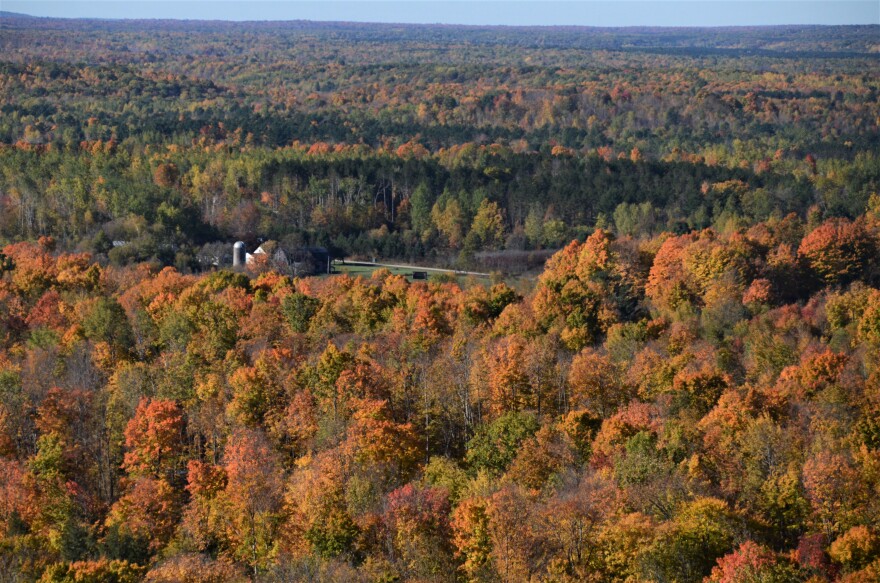Called the “Immediate Expansion of American Timber Production”, President Trump’s Executive Order calls for reducing the impact of what he calls “heavy-handed Federal policies” so that the U.S. can increase timber production and reduce wildfire risk.
The order directs the Secretary of the Interior and the Secretary of Agriculture to look at how to increase timber harvest and cut down on delivery time and supply uncertainty on Forest Service and Bureau of Land Management land.
This includes taking a look at how things like the Endangered Species Act and National Environmental Policy Act can impact the process.
Henry Schienebeck is the Executive Director of the Great Lakes Timber Professionals Association.
He doesn’t know that the order will have a huge impact in this region, because it’s already one of the top timber producing regions within the Forest Service, but he does believe there’s room for improvement.
Schienebeck says the Chequamegon Nicolet National Forest has made a lot of progress towards its harvest goals because of the Good Neighbor Authority that’s allowed it to partner with the Wisconsin DNR to setup timber sales.
“We've been able to catch up on a lot of that forest management, those have been excellent tools with forest stewardship and Good Neighbor Authority to get caught up on some of the work that we're behind,” he said.
Schienebeck says there are a lot of opportunities to use natural wood in products like sustainable aviation fuel, biochar, and mass timber.
“People are starting to see the value of using wood more, real wood, for building their homes and that type of thing. I think from that aspect, we have some huge opportunity here,” said Schienebeck.
Schienebeck does think the order could be a positive thing for western states where wildfires are more common and destructive.
“We've been able to avoid that in the lake states to a great degree, and it is because we've got highly trained loggers that are out there managing the forest,” said Schienebeck. “We've got mills to absorb the wood, and we've got certification systems that are really a check and balance to make sure that we're doing the job right.”
Schienebeck stressed he doesn’t believe this will lead to mass clear cutting for forests like the state saw in the late 1800s. He says that sustainable timber harvest is good for both healthy forests and a healthy forest products industry.
“Our main focus is to make sure that we always have trees and that we always have access to them,” said Schienebeck. “It wouldn't be in our best interest to just go cut the forest and not have any trees left.”
More than timber production
Environmental groups like the Center for Biological Diversity believe speeding up the timber process will hurt critical wildlife habitat, impact water quality, and actually increase wildfire risk.
“Trump’s order will unleash the chainsaws and bulldozers on our beautiful, irreplaceable federal forests,” public lands policy director at the Center for Biological Diversity Randi Spivak in a statement. “Clearcutting these amazing national treasures will increase fire risk, drive imperiled wildlife to extinction, pollute our rivers and streams, and destroy world-class recreation sites.”
Wisconsin’s Green Fire is a conservation group which focuses on a science-based approached to managing natural resources. Ron Eckstein is part of the organization’s Public Lands and Forestry Work group.
He doesn’t believe you have to change or lessen environmental protections to harvest timber. He points to the Chequamegon Nicolet National Forest as a good example of balancing timber production and other natural resources.
The Chequamegon Nicolet is regularly one of the top timber producing National Forests in the Forest Service System selling roughly 120 million board feet of timber annually.
“They really are harvesting a lot of timber, and they've done that by following all the rules, the Endangered Species Act, the National Environmental Policy Act, and the forest plan,” said Eckstein.
Eckstein also says while timber is a big product of the National Forest System, so is wildlife habitat, water quality, and recreation.
“These are all elements of the National Forest. Timber just being one of them,” said Eckstein. “If you just say, okay, timber and forget about everything else that really, really doesn't work very well.”
Eckstein also called it “inconsistent” to order an increase in timber production while cutting thousands of Forest Service staff that manage the land.
Wisconsin’s Forest Products Industry
Late last year, Wisconsin’s Green Fire published a report that looked at the health of all forests in the state, of which federal forest land makes up less than 10%.
The report details how a declining forest products industry, invasive species, and climate change are among the threats to healthy forests.
“We have a lot of timber in Wisconsin, and it can be harvested sustainably using our own information. Most of the timber is on private land, some is on public land, and landowners, whether it's private or public, landowners need a way to get the timber to market and have a market for the timber,” said Eckstein.
Schienebeck says the timber industry in the Great Lakes is “a mixed bag” right now.
The region lost some key mills in 2020/2021 that the industry is still feeling the impacts of, but there are still a lot of resources.
He says more infrastructure, both locally and across the U.S., will be needed to support the kind of timber demand the Trump administration has been calling for, but mills need guarantees that demand will last beyond this administration.
“I don't see any mill that's going to want to invest a lot of money in increasing their production without having some guarantees that the volume is going to be there into the future,” said Schienebeck.






